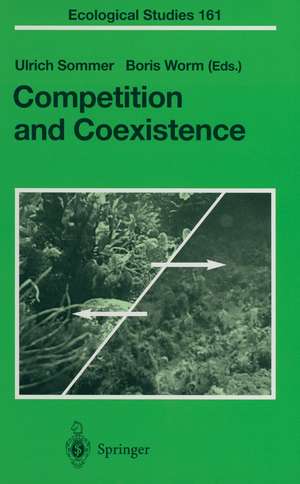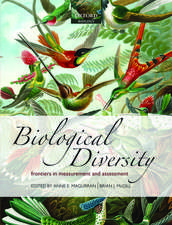Competition and Coexistence: Ecological Studies, cartea 161
Editat de Ulrich Sommer, Boris Wormen Limba Engleză Paperback – 28 oct 2012
| Toate formatele și edițiile | Preț | Express |
|---|---|---|
| Paperback (1) | 637.78 lei 6-8 săpt. | |
| Springer Berlin, Heidelberg – 28 oct 2012 | 637.78 lei 6-8 săpt. | |
| Hardback (1) | 702.24 lei 6-8 săpt. | |
| Springer – 18 sep 2002 | 702.24 lei 6-8 săpt. |
Din seria Ecological Studies
- 18%
 Preț: 1118.93 lei
Preț: 1118.93 lei -
 Preț: 553.72 lei
Preț: 553.72 lei - 18%
 Preț: 1680.55 lei
Preț: 1680.55 lei - 18%
 Preț: 1003.38 lei
Preț: 1003.38 lei - 20%
 Preț: 1004.71 lei
Preț: 1004.71 lei -
 Preț: 480.62 lei
Preț: 480.62 lei - 5%
 Preț: 752.26 lei
Preț: 752.26 lei - 15%
 Preț: 643.99 lei
Preț: 643.99 lei - 15%
 Preț: 644.18 lei
Preț: 644.18 lei - 15%
 Preț: 652.49 lei
Preț: 652.49 lei - 18%
 Preț: 789.83 lei
Preț: 789.83 lei -
 Preț: 382.36 lei
Preț: 382.36 lei - 15%
 Preț: 643.48 lei
Preț: 643.48 lei - 15%
 Preț: 646.30 lei
Preț: 646.30 lei - 15%
 Preț: 634.32 lei
Preț: 634.32 lei -
 Preț: 384.86 lei
Preț: 384.86 lei - 18%
 Preț: 789.98 lei
Preț: 789.98 lei - 15%
 Preț: 645.14 lei
Preț: 645.14 lei - 15%
 Preț: 649.39 lei
Preț: 649.39 lei - 18%
 Preț: 1005.43 lei
Preț: 1005.43 lei - 18%
 Preț: 949.23 lei
Preț: 949.23 lei - 15%
 Preț: 649.54 lei
Preț: 649.54 lei - 15%
 Preț: 643.34 lei
Preț: 643.34 lei - 15%
 Preț: 649.71 lei
Preț: 649.71 lei - 15%
 Preț: 638.76 lei
Preț: 638.76 lei - 18%
 Preț: 957.62 lei
Preț: 957.62 lei - 18%
 Preț: 1235.25 lei
Preț: 1235.25 lei - 18%
 Preț: 962.18 lei
Preț: 962.18 lei - 18%
 Preț: 949.23 lei
Preț: 949.23 lei - 15%
 Preț: 660.68 lei
Preț: 660.68 lei -
 Preț: 397.76 lei
Preț: 397.76 lei - 15%
 Preț: 638.24 lei
Preț: 638.24 lei - 18%
 Preț: 942.31 lei
Preț: 942.31 lei - 18%
 Preț: 1232.57 lei
Preț: 1232.57 lei - 15%
 Preț: 651.34 lei
Preț: 651.34 lei - 18%
 Preț: 952.72 lei
Preț: 952.72 lei - 18%
 Preț: 1834.27 lei
Preț: 1834.27 lei - 18%
 Preț: 1229.10 lei
Preț: 1229.10 lei -
 Preț: 423.95 lei
Preț: 423.95 lei - 18%
 Preț: 948.92 lei
Preț: 948.92 lei
Preț: 637.78 lei
Preț vechi: 750.33 lei
-15% Nou
Puncte Express: 957
Preț estimativ în valută:
122.04€ • 130.50$ • 101.75£
122.04€ • 130.50$ • 101.75£
Carte tipărită la comandă
Livrare economică 18 aprilie-02 mai
Preluare comenzi: 021 569.72.76
Specificații
ISBN-13: 9783642628009
ISBN-10: 3642628001
Pagini: 240
Ilustrații: XI, 223 p.
Dimensiuni: 155 x 235 x 13 mm
Greutate: 0.35 kg
Ediția:Softcover reprint of the original 1st ed. 2002
Editura: Springer Berlin, Heidelberg
Colecția Springer
Seria Ecological Studies
Locul publicării:Berlin, Heidelberg, Germany
ISBN-10: 3642628001
Pagini: 240
Ilustrații: XI, 223 p.
Dimensiuni: 155 x 235 x 13 mm
Greutate: 0.35 kg
Ediția:Softcover reprint of the original 1st ed. 2002
Editura: Springer Berlin, Heidelberg
Colecția Springer
Seria Ecological Studies
Locul publicării:Berlin, Heidelberg, Germany
Public țintă
ResearchCuprins
1 Introduction.- 1.1 The Intellectual Debate Until 1990.- 1.2 Progress During the Last Decade.- 1.3 Consequences for the Structure of the Book.- References.- 2 Competition in Well-Mixed Habitats: From Competitive Exclusion to Competitive Chaos.- 2.1 Introduction.- 2.2 Competition for a Single Abiotic Resource.- 2.3 Resource Storage.- 2.4 Competition for a Single Biotic Resource.- 2.5 Competition for Two Resources.- 2.6 Competition for Three Resources.- 2.7 Discussion.- References.- 3 Spatial Models of Competition.- 3.1 Introduction.- 3.2 Implicitly Spatial Models.- 3.3 Explicitly Spatial Models.- 3.4 Comparing and Connecting Methods.- 3.5 Underlying Spatial Heterogeneity.- 3.6 Competition and Coexistence.- 3.7 Future Directions.- References.- 4 Competition and Coexistence in Plankton Communities.- 4.1 Introduction.- 4.2 Competition Experiments in Laboratory Microcosms.- 4.3 Experiments in Field Mesocosms.- 4.4 Tests of the Intermediate Disturbance Hypothesis by Field Data.- 4.5 Herbivory and Diversity.- 4.6 The Role of Abundance and of Seasonality.- 4.7 Conclusions.- References.- 5 Competition and Coexistence in Mobile Animals.- 5.1 Introduction.- 5.2 Competition Among Mobile Animals.- 5.3 Heterogeneity, Trade-Offs, and Competition.- 5.4 Scale and Heterogeneity.- 5.5 New Challenges.- References.- 6 Competition, Coexistence and Diversity on Rocky Shores.- 6.1 Introduction.- 6.2 Disruption of Competitive Exclusion: The Non-Equilibrium View.- 6.3 Coexistence Through Trade-Offs: The Equilibrium View.- 6.4 Synthesis: Integrating the Effects of Competition, Consumption and Disturbance.- 6.5 Conclusion.- References.- 7 Competition and Coexistence in Terrestrial Plants.- 7.1 Introduction.- 7.2 Competition.- 7.3 Coexistence.- 7.4 Conclusion.- References.- 8 Synthesis: Back to Santa Rosalia, or No Wonder There Are So Many Species.- 8.1 Trade-Offs.- 8.2 Disturbance, Predation and Competition.- 8.3 The Spatial Dimension.- 8.4 Self-Generated Heterogeneity.- 8.5 Exclusive Resources.- 8.6 Slow Exclusion.- 8.7 Equilibrium vs. Non-Equilibrium Concepts.- 8.8 Future Challenges.- References.
Recenzii
From the reviews:
"... I found this book easy to read, with a concise and consistent style across chapters. Figures were clearly presented and effectively described. I would recommend this as a good introduction to current models and empirical studies of the role of competition in structuring communities for those not already familiar with the topic." (Ethology)
"Plant ecologists working on traditional problems of vegetation composition and tradeoffs among component species for limiting resources will derive a great deal from the book. It comprises a convenient and approachable primer on the theory of competition and coexistence and its real-life applications, and it would make for an excellent graduate-level seminar." (Plant Systematics and Evolution)
"This volume is an attempt to review and synthesize recent research on competition-coexistence relationships … . Overall, I found this book easy to read, with a concise and consistent style across chapters. Figures were clearly presented and effectively described. I would recommend this as a good introduction to current models and empirical studies of the role of competition in structuring communities for those not already familiar with this topic." (Tad Theimer, Ethology, Issue 12, 2003)
"... I found this book easy to read, with a concise and consistent style across chapters. Figures were clearly presented and effectively described. I would recommend this as a good introduction to current models and empirical studies of the role of competition in structuring communities for those not already familiar with the topic." (Ethology)
"Plant ecologists working on traditional problems of vegetation composition and tradeoffs among component species for limiting resources will derive a great deal from the book. It comprises a convenient and approachable primer on the theory of competition and coexistence and its real-life applications, and it would make for an excellent graduate-level seminar." (Plant Systematics and Evolution)
"This volume is an attempt to review and synthesize recent research on competition-coexistence relationships … . Overall, I found this book easy to read, with a concise and consistent style across chapters. Figures were clearly presented and effectively described. I would recommend this as a good introduction to current models and empirical studies of the role of competition in structuring communities for those not already familiar with this topic." (Tad Theimer, Ethology, Issue 12, 2003)
Caracteristici
Features a new, spatial view of competition and coexistence Provides an overview of regulatory mechanisms that sustain biodiversity in ecosystems Includes supplementary material: sn.pub/extras










